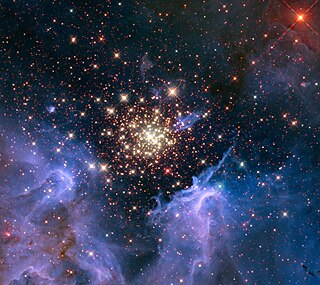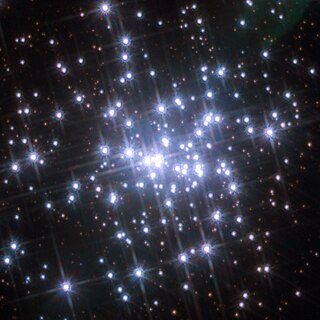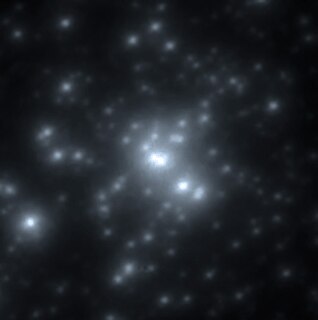
Wolf–Rayet stars, often abbreviated as WR stars, are a rare heterogeneous set of stars with unusual spectra showing prominent broad emission lines of ionised helium and highly ionised nitrogen or carbon. The spectra indicate very high surface enhancement of heavy elements, depletion of hydrogen, and strong stellar winds. Their surface temperatures range from 30,000 K to around 210,000 K, hotter than almost all other stars. They were previously called W-type stars referring to their spectral classification.

The Carina Nebula is a large, complex area of bright and dark nebulosity in the constellation Carina, and is located in the Carina–Sagittarius Arm. The nebula is approximately 8,500 light-years (2,600 pc) from Earth.

NGC 3603 is a nebula situated in the Carina spiral arm of the Milky Way around 20,000 light-years away from the Solar System. It is a massive HII region containing a very compact open cluster HD 97950.

Sher 25 is a blue supergiant star in the constellation Carina, located approximately 25,000 light years from the Sun in the H II region NGC 3603 of the Milky Way. It is a spectral type B1Iab star with an apparent magnitude of 12.2. Its initial main sequence mass is calculated at 60 times the mass of our Sun, but a star of this type will have already lost a substantial fraction of that mass. It is unclear whether Sher 25 has been through a red supergiant phase or has just evolved from the main sequence, so the current mass is very uncertain.

R136 is the central concentration of stars in the NGC 2070 star cluster, which lies at the centre of the Tarantula Nebula in the Large Magellanic Cloud. When originally named it was an unresolved stellar object but is now known to include 72 class O and Wolf–Rayet stars within 5 parsecs of the centre of the cluster. The extreme number and concentration of young massive stars in this part of the LMC qualifies it as a starburst region.

NGC 3603-A1 is a double-eclipsing binary star system located at the centre of the HD 97950 cluster in the NGC 3603 star-forming region, about 25,000 light years from Earth. Both stars are of spectral type WN6h and among the most luminous and most massive known.

WR 7 is a Wolf–Rayet star in the constellation of Canis Major. It lies at the centre of a complex bubble of gas which is shocked and partially ionised by the star's radiation and winds.

HD 97950, is a multiple star system and part of a super star cluster within the NGC 3603 H II region. It was catalogued as a single star although it was always known to be a compact cluster. It is now resolved into a massive multiple star at the centre of one of the densest clusters in the galaxy.

HD 5980 is a multiple star system in NGC 346 in the Small Magellanic Cloud (SMC) and is one of the brightest stars in the SMC.

AB7, also known as SMC WR7, is a binary star in the Small Magellanic Cloud. A Wolf–Rayet star and a supergiant companion of spectral type O orbit in a period of 19.56 days. The system is surrounded by a ring-shaped nebula known as a bubble nebula.

WR 25 is a binary star system in the turbulent star forming region Carina Nebula, about 6,800 light-years from Earth. It contains a Wolf-Rayet star and a hot luminous companion, and is a member of the Trumpler 16 cluster.

R136a3 is a Wolf–Rayet star in R136, a massive star cluster located in Dorado. It is located near R136a1, the most massive and luminous star known. R136a3 is itself one of the most massive and most luminous stars known at 180 times more massive and 3.8 million times more luminous than the Sun.

WR 24 is a Wolf-Rayet star in the constellation Carina. It is one of the most luminous stars known. At the edge of naked eye visibility it is also one of the brightest Wolf Rayet stars in the sky.

NGC 3603-C is a single-lined spectroscopic binary star system located at the centre of the HD 97950 cluster in the NGC 3603 star-forming region, about 25,000 light years from Earth. The primary has spectral type WN6h and is among the most luminous and most massive known.

WR 42e is a Wolf-Rayet star in the massive H II region NGC 3603 in the constellation of the Carina. It is around 25,000 light years or 7,600 parsec from the Sun. WR 42e is one of the most massive and most luminous stars known.
R99 is a star in the Large Magellanic Cloud in the constellation Dorado. It is classified as a possible luminous blue variable and is one of the most luminous stars known.
CD Crucis, also known as HD 311884, is an eclipsing binary star system in the constellation Crux. It is around 14,000 light years away near the faint open cluster Hogg 15. The binary contains a Wolf–Rayet star and is also known as WR 47.
WR 111 is a Wolf-Rayet (WR) star in the constellation Sagittarius (constellation). It is magnitude 7.8 and lies about 5,150 light-years away. It is one of the brightest and most closely studied WR stars.
WR 2 is a Wolf-Rayet star located around 8,000 light years away from Earth in the constellation of Cassiopeia. It is smaller than the sun, but due to a temperature over 140,000 K it is 282,000 times as luminous as the sun.

HD 151932, also known as WR 78, is a Wolf-Rayet star located in the constellation Scorpius, close to the galactic plane. Its distance is around 1,300 parsecs away from the Earth. Despite being a blue-colored Wolf-Rayet star, it is extremely reddened by interstellar extinction, so its apparent magnitude is brighter for longer-wavelength passbands. HD 151932 lies about 22′ west of the open cluster NGC 6231, the center of the OB association Scorpius OB1; it is not clear whether it is a part of the association or not. With an apparent magnitude of about 6.5, it is one of the few Wolf-Rayet stars that can be seen with the naked eye.













